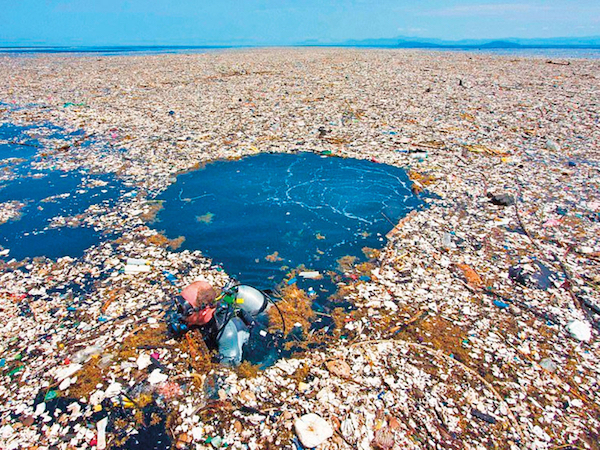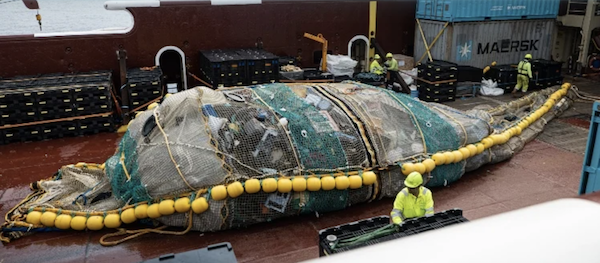


(quote)
A Dutch Teenager Had a Dream to Clean Up the World’s Oceans. 7 Years On, It’s Coming True
For someone who gets violently seasick, Boyan Slat spends a lot of time thinking about the ocean. The Dutch inventor has designed the world’s first ocean plastic cleanup system but admits he won’t be on the ship with it when it launches out of San Francisco on Saturday. “I am not a man of the sea,” he says.
After five and a half years of hard work, the 23-year-old Slat will watch from dry land as System 001 — a floating barrier nearly 2,000ft long — snakes its way out under the Golden Gate Bridge into the Pacific. Its destination is the Great Pacific Garbage Patch, a gyre of plastic waste twice the size of Texas held in position by ocean currents between California and Hawaii.
If all goes to plan, Slat says, an array of 60 systems could reduce the amount of plastic there by half by 2025. “I hope that this will be a turning point for the plastic pollution problem,” Slat tells TIME in a phone interview a few days before the launch, in between final preparations. “For sixty years it has only gotten worse and worse. Now hopefully we’re turning the tide.”
The eradication of the garbage patch, and more broadly the salvation of our oceans, has been Slat’s single-minded goal ever since he was 16 years old, when a diving trip to Greece yielded more plastic bag sightings than fish. Struck by the idea for a floating barrier that could collect plastic using the power of ocean currents alone, he founded his company, The Ocean Cleanup, aged just 18.
But reducing our addiction to plastic is just one half of the equation, Slat says. “These garbage patches won’t go away by themselves. Even if we were to close the tap today the plastic would still be there in 100 years.”
Slat sees his mission as a race against time. Plastic gradually breaks down into smaller and smaller pieces called microplastics which can eventually enter the food chain. Currently, however, just 8% of the plastic mass in the Pacific garbage patch is microplastics, according to research carried out by The Ocean Cleanup published in the journal Scientific Reports. “But of course what’s going to happen over the next few decades is that all the other 92% of plastic will be turned into microplastics as well,” Slat says. “So the sooner we get it out, the better.”
Video: A giant trash vortex’s growing in the ocean. Now a cleanup effort’s underway.
10 Yrs After Vowing To Clean Up Ocean, Man Makes History With Life-Changing Invention
More than 24 trillion pounds of plastic wind up in the oceans annually. Experts think that this amount will triple by 2040 — unless we take action now.
Boyan’s non-profit The Ocean Clean Up Project has worked tirelessly to clean up waterway pollution for the past 10 years. They’ve had success with their innovative river-cleaning technology, and their newest version of an ocean cleaning device recently went through its first 12-week testing period. The results were better than anyone could have hoped!
System002, also called Jenny, is a carbon-neutral system designed to collect even the tiniest microplastic from the sea, all without harming marine wildlife. Two boats drag a long net between them to gather the trash, and it’s then brought onto a barge to be recycled back on shore.
On the last day of Jenny’s 12-week trial, Boyan shared his reaction to the project’s success with four simple words: “Holy mother of god,” he tweeted. “It’s exactly 10 years ago that I first learned about the Great Pacific Garbage Patch,” Boyan wrote on Twitter. “Back then, everyone told me there was no hope of ever cleaning it up. They were right then; no method existed to do it. Proud (and relieved!) to say that now there is.”
Boyan hopes to have many more Jennies to work in the coming years. He estimates that 10 Jennies could clean half of the largest garbage patch in just 5 years. The ultimate goal is to have 90% of the garbage patch removed by 2040!
Dutch Inventor Launches Ocean Cleanup Mission
Boyan Slat was just a regular Dutch high-school student when he went on a diving trip to Greece in 2011. Once underwater, he was surrounded by plastic waste. “There were more plastic bags than fish,” he told MNN a few years back. “That was the moment I realized it was a huge issue and that environmental issues are really the biggest problems my generation will face.”
Like many of us, Slat had heard about various giant garbage patches the world over, and he figured that someone, somewhere, was working to solve it. During his research after the Greece trip, he learned that there were a few cleanup ideas out there, but most of them relied on using nets to filter the plastic out of the water. Those nets also scooped up a lot of fish, turtles and other sea life, and weren’t practical. So he developed his own solution.
“I finally decided to put both university and my social life on hold to focus all my time on developing this idea. I wasn’t sure if it would succeed, but considering the scale of the problem, I thought it was important to at least try,” Slat said.
The Great Pacific Garbage Patch is the largest accumulation of ocean plastic in the world and is located between Hawaii and California. Scientists of The Ocean Cleanup have conducted the most extensive analysis ever of this area.
It is estimated that 1.15 to 2.41 million tonnes of plastic are entering the ocean each year from rivers. More than half of this plastic is less dense than the water, meaning that it will not sink once it encounters the sea.
The stronger, more buoyant plastics show resiliency in the marine environment, allowing them to be transported over extended distances. They persist at the sea surface as they make their way offshore, transported by converging currents and finally accumulating in the patch.
Once these plastics enter the gyre, they are unlikely to leave the area until they degrade into smaller microplastics under the effects of sun, waves and marine life. As more and more plastics are discarded into the environment, microplastic concentration in the Great Pacific Garbage Patch will only continue to increase.
In the Pacific Ocean, two massive floating islands of trash extend for hundreds of miles, together making up the Great Pacific Garbage Patch. The pervasive vortices of human-made garbage damage marine life, as well as the environment, and can even exacerbate human-caused climate change.
In August, the environmental nonprofit Ocean Cleanup deployed Jenny, its first large-scale cleaning system, which has since removed more than 63,000 pounds of trash. In October, Ocean Cleanup called that work the “beginning of the end of the Great Pacific Garbage Patch.” It’s a start. But the clumps of human-made trash are getting larger.
Skip the plastic, save a fish. Texas-sized ocean garbage vortex found in Pacific, plastic sea trash doesn’t biodegrade
Shocking gigantic sight of ocean debris is found in the Pacific. The Texas-sized Pacific Ocean garbage patch is a vortex formed by ocean currents & collects human-produced trash. Plastic sea trash doesn’t biodegrade and often floats at the surface. Bottlecaps, bags and wrappers that end up in the ocean from the wind or through overflowing sewage systems can then drift thousands of miles. “Seeing that influence just floating out here in the middle of nowhere makes our power painfully obvious, and the consequences of the industrial age plain.” Plastics have entangled birds and turned up in the bellies of fish, and one paper cited by the National Oceanic and Atmospheric Administration estimates 100,000 marine mammals die trash-related deaths each year.
(unquote)
Image courtesy The Ocean Cleanup, inspiremore, and AFP






